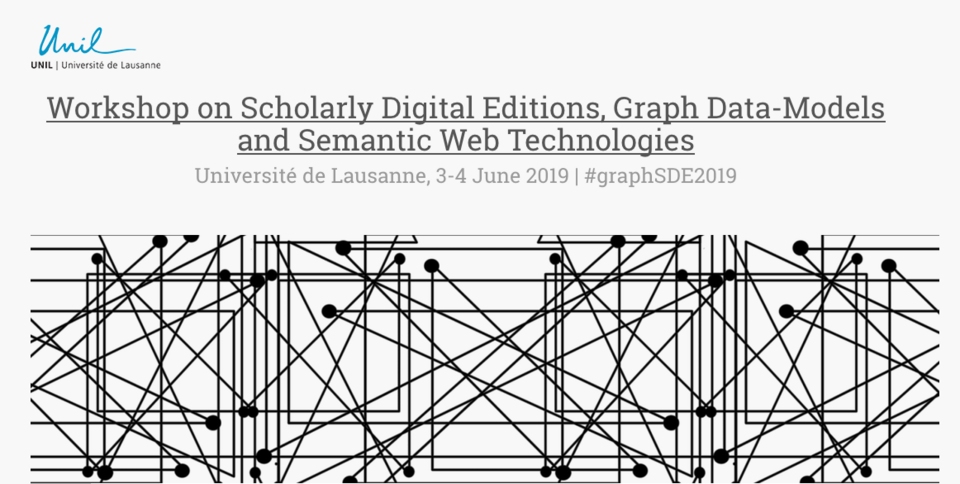/ vc
CFP: Workshop on Scholarly Digital Editions, Graph Data-Models and Semantic Web Technologies, Université de Lausanne, 3-4 June 2019

Université de Lausanne, 3-4 June 2019 | #graphSDE2019 Digital texts processed by machines are linear strings of characters, but in most research activities in the Humanities (philology, linguistics, corpus-based analysis, cultural heritage, etc.) we store them in databases and we add markup to the text, that is a kind of intelligence made computable thanks to the use of widespread data-models, formats and standards. Invited speakers: Tobias Schweizer, Sepideh Alassi (University of Basel – Digital Humanities Lab)
Digital texts processed by machines are linear strings of characters, but in most research activities in the Humanities (philology, linguistics, corpus-based analysis, cultural heritage, etc.) we store them in databases and we add markup to the text, that is a kind of intelligence made computable thanks to the use of widespread data-models, formats and standards.
In the last decades, the popularity of graph data-models has increased, in accordance with the semantic web proposition and the development of standards such as RDF and OWL. Graph databases, in the form of triple stores (such as Graph-DB) or of labeled-property-graphs (Neo4j), are regarded as powerful and flexible solutions by research and cultural institutions, and private companies alike.
The workshop is held to explore possible interactions between digital texts, the graph data-model, scholarly editions and the semantic web. The combinations of these objects/concepts, pursued in the last decades, remains experimental to date, and it represents one of the possible developments for the field of digital scholarly editing.
We are please to welcome the workshop invited speakers:
- Ronald Haentjens Dekker (Royal Dutch Academy of Sciences – Humanities Cluster)
- Samuel Müller (University of Basel – National Infrastructure for Editions)
- Michele Pasin (Springer Nature)
- Tobias Schweizer, Sepideh Alassi (University of Basel – Digital Humanities Lab)
- Georg Vogeler (University of Graz)
The workshop would not be possible without its scientific committee:
- Gioele Barabucci (University of Cologne)
- Fabio Ciotti (University of Rome Tor Vergata)
- Claire Clivaz (Swiss Institute of Bioinformatics)
- Marion Rivoal (DASCH – University of Lausanne)
- Greta Franzini (Università Cattolica del Sacro Cuore)
- Simon Gabay (University of Neuchâtel)
- Daniel Maggetti (University of Lausanne)
- Frederike Neuber (Berlin-Brandenburg Academy of Sciences and Humanities)
- Elena Pierazzo (University of Grenoble-Alpes)
- Davide Picca (University of Lausanne)
- Michael Piotrowski (University of Lausanne)
- Matteo Romanello (EPFL)
- Maïeul Rouquette (University of Lausanne)
- Elena Spadini (University of Lausanne)
- Francesca Tomasi (University of Bologna)
- Aris Xanthos (University of Lausanne)
The organizers of the workshop are
- Elena Spadini (University of Lausanne, CRLR)
- Francesca Tomasi (University of Bologna)
With the support of
- Centre de recherche sur les lettres romandes (CRLR), Université de Lausanne
- Fonds national suisse de la recherche scientifique | Swiss National Science Foundation [‘Scientific exchange’ scheme]
In collaboration with
- Digital Humanities and Digital Knowledge (DHDK), University of Bologna
- Section des sciences du langage et de l’information (SLI), University of Lausanne
- Lausanne Laboratory for Computational and Statistical Text Analysis (LLIST)
Quick Links
